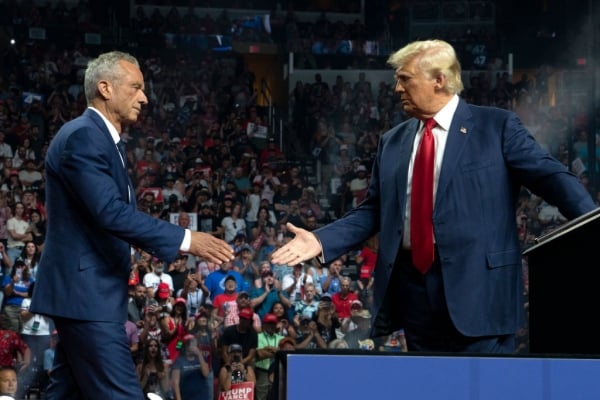In his new podcast series, Gatecrashers: The Hidden History of Jews and the Ivy League (Tablet), Mark Oppenheimer, writer and co-host of the podcast Unorthodox, examines how elite institutions sought to limit the number of Jewish students a century ago—and how the advent of that quota system has shaped U.S. higher education ever since. Oppenheimer spoke with Inside Higher Ed by phone. Excerpts of the conversation follow, edited for length and clarity.
Q: Your podcast is very timely given that the Supreme Court is expected to hear oral arguments in the Harvard and UNC affirmative action cases next month. What, if anything, has changed since the Ivy League first sought to impose quotas on Jewish students a century ago?
A: We’re talking literally about exactly a century ago, give or take a year, when Columbia, Harvard and Yale all first ventured into artificially restricting the number of Jews who would be admitted. Simply put, the big difference is that back then, diversity was seen as an unquestionably bad thing. And now diversity is seen as unquestionably a good thing. And so, back then, restricting the people who got in was an attempt to thwart a certain kind of ethnic diversity. And today, there are probably unspoken quotas in existence that are meant to enhance a certain kind of diversity.
The same devices that were being used back then are being used today. Think about the idea of geographical diversity. It seems so completely benign on the surface, a college saying that we have students from all 50 states. But that idea was invented by Columbia, and quickly adopted by other Ivy League schools, because they found that they were admitting an extraordinary number of New Yorkers who were disproportionately Jewish. One of the ways that you could limit the number of Jews was by sending these newly created admissions recruitment squads around to Western and Southern states, in places with lower Jewish populations, and instead of saying, “We’re going to recruit Gentiles,” you could just say, “We’re going to recruit Southerners or Westerners,” which was seen as an incredibly good thing. All of these things that are baked into the admission process today—geographical diversity, the interview, legacy preferences—were invented expressly to keep the number of Jews down.
 Q: Isn’t imposing quotas to increase diversity better than imposing them to limit diversity?
Q: Isn’t imposing quotas to increase diversity better than imposing them to limit diversity?
A: I mean, it’s very tricky. On the one hand, I think it’s progress that nobody is sitting in admissions offices right now talking about the “good” kind of Jew versus the “bad” kind of Jew—the assimilable Jew versus the unassimilable Jew. It’s progress that they’re no longer having conversations, as Dartmouth did, asking Jewish alumni to counsel the admissions office on how to get the “right” kind of Jew from among their own people.
On the other hand, the ways that a school like Harvard, it seems, is achieving its more admirable kind of diversity now, inevitably turn on mechanisms that reduce individual candidates to stereotypes. And the same stereotype that admissions officers had of Jews back in 1920—that they were nerds, they were grinds, they didn’t have the character to take full advantage of all of the extracurricular offerings because they would just go home at night to study—are absolutely the same stereotypes that are at play when Harvard assigns a ranking to something like character or courage and disproportionately grades down Asian American applicants. These things were pernicious then, and they’re pernicious now. And the other thing that they do in both cases, is they insert an element of dishonesty into the process.
Q: How so?
A: These universities are set up for—and given tax exemption for—the purpose of being little islands of unadorned truth in our society, and yet admissions offices are probably the most dishonest places at these universities. They lack transparency. They can’t talk about how they get to the numbers they get to. They can’t talk about what they’re aiming for in a class. I am sure that all top schools that can afford to be selective are hoping, for example, that the number of African Americans in their freshman classes approximates the 12 percent of African Americans in the United States, and probably the same for Latinos.
Nobody talks about, if they can avoid it, how different groups score on different indices that the admissions officers come up with, whether grades, SATs or these subjective markers of character, courage, etc. All these things might be benign, or even defensible, or even admirable. But they should be discussed and talked about openly. We shouldn’t pretend they don’t exist. I’m not necessarily against any of these measures. What I think we have to scrutinize more is why there is so much secrecy around them.
Q: Each of the eight episodes in the series looks at how Jews were received and treated by one Ivy League institution. In what ways was the experience for the Jewish students at each university similar, and in what ways was it different?
A: The Ivy League schools were in many ways quite similar in the 1920s, in that they were all in the process of becoming highly competitive bastions of status. Fifty years earlier, all the Ivy League schools were fairly provincial, and they did a relatively small number of things, whether it was training students for the clergy, or, as at Cornell, training them for agriculture. By 1920, they all developed this aspiration of being competitive places that students who want to succeed and be in the upper classes can matriculate at. They were all becoming more appealing nationally in different ways.
Columbia, being in New York City, started drawing enormous numbers of applicants from the public schools, which it never had. But remember, these universities were fairly cheap back then. So if you were a bright boy graduating from Stuyvesant or Bronx Science in 1920, and your family had a little bit of money, you might as well apply to Columbia as well as City College and NYU, because it wasn’t necessarily out of range, moneywise. All of a sudden, the number of applicants from New York City started going way, way up. Princeton, back then, was much more oriented toward the South; it was seen as more of a Cavalier school, and it was not as appealing to Jews. Also, schools like Princeton and Dartmouth did not have as many professional schools. So if you were a Jewish boy trying to get into the middle class, you couldn’t assume you’d have a spot in Daddy’s banking firm; you needed to go to law school or med school or dentistry school. Princeton or Dartmouth didn’t have as much for you, so those schools were much slower to be appealing, whereas the urban schools with lots of professional schools, like Harvard and Columbia, were really the first to become extremely popular.
Q: A huge share of the Jewish students who attended Ivy League schools back in the ’20s were the children of immigrants. How much of the discrimination against them was rooted in religion and how much in class?
A: Very little of it had to do with Jews’ adherence to Torah, specifically. Nobody was saying, “We need more Christ followers and fewer sons of Moses!” It was threefold: one, there was an ethnic prejudice that partook of certain stereotypes of Jews as lacking class, as being grasping or overly ambitious. Secondly, it was a prejudice against immigrants at a time when America was going through a very nativist period. The 1920s were a time when we were afraid of immigrants, like today, so a lot of it was a basic nativist concern about Jewish immigration, Italian immigration, Irish immigration and so forth. And then the third piece really was a simple question of socioeconomic status, of whether poor kids could or should be allowed to mix with wealthier kids who knew which fork to use.
Q: You point out that basically anybody who was sort of athletic and—as you said—knew which fork to use was socially accepted.
A: There was always room for the “good Jew” in the eating clubs at Princeton. There was always the sense that Jews from wealthy families or from the right private schools could be admitted. And so in the Princeton episode, the Jews who didn’t get into the eating clubs were by and large Jews who were from public schools, who were not on sports teams. And also, if you believe [my interview with] one of the Jews in the sophomore class of 1958, Jews who didn’t dress well, weren’t tall enough and, worst of all, were intellectuals. You have to remember how anti-intellectual these schools were. They were deeply concerned about being seen as schools where everyone was concerned with study and learning all the time—that was a bad thing. It was thought that the qualities of leadership necessitated a kind of well-rounded, almost indifference to the life of the mind.
Q: How did the geopolitical events of the time impact the Jewish quotas in the Ivy League?
A: There were two moments when world events really intruded on American admissions. One was, after the full horrors of the Holocaust and World War II were assimilated, in the mid- to late 1940s, it became really untenable to keep talking about people in gross, crass ethnic stereotypes. And so, nominally anyway, in the 1950s, these schools developed a rhetoric of civil rights and toleration. In practice, they didn’t necessarily admit many more Jews or African Americans until the 1960s. But in the late 1940s and 1950s, they began to develop a sense of shame about the racial and religious prejudice that marked the interwar era.
The second moment was after the [1957] launch of Sputnik, when Americans grew very concerned that Russians were winning the space war, that we were falling behind in technology. And at Yale, for example, they pretty explicitly decided that they had to start admitting more for intellectual heft than just for, you know, skill with a squash racket and a good tenor voice.
Q: You note that there are fewer Jews in the Ivy League now than there were 20 or 30 years ago. Why is that?
A: There are a number of factors at play. Certainly, the search for more students from historically underrepresented groups has squeezed out, to some extent, the number of Ashkenazi Jews, who are considered white. Also, the increase in the number of international students as a percentage of each freshman class has surely reduced the percentage of Jews; by and large, these students are not coming from Israel, and they’re not Jews from other countries. They’re very often from East Asia, South Asia, the Arab Gulf and so forth. And then a potential third reason is because the farther any group gets from the immigrants’ industriousness, the more they revert to the mean of average American. There’s no particular reason to believe that there are as many Jewish boys and girls working as hard or as hungrily to break into the middle class, now that, by and large, most American Jews have made it into the middle and upper middle class.
Q: At Inside Higher Ed, we’ve written a lot about the rise of antisemitism on campus today. Do you think it’s connected in any way to the old Jewish quota system, or does it stem from something else?
A: The thing is, stereotypes persist, right? Wherever you see antisemitic posters, antisemitic graffiti, antisemitic memes on the internet, the chances are pretty good that they’re going to hark back to some of the same old stereotypes of Jews as clannish, as grasping, as miserly, as conspiratorial. There really is nothing new under the sun.
Q: One thing that is different is the creation of the state of Israel, which didn’t exist in the ’20s. Today it seems like so much of the antisemitism on campus is linked to Zionism.
A: That’s true, although what’s interesting is that the idea of dismissing Jews, of loathing Jews because of some supposed connection to a foreign government, strikes me as awfully reminiscent of the old trope of Jews as clannish and untrustworthy that you saw in the 1920s and ’30s. In the 1930s, the idea was that they’re not trustworthy, they’re trying to lure us into war on behalf of a foreign power. And how is a lot of anti-Zionism fashioned now, except that the Jews aren’t trustworthy, they’re trying to lure us into wars on behalf of foreign powers?





















Discussion about this post